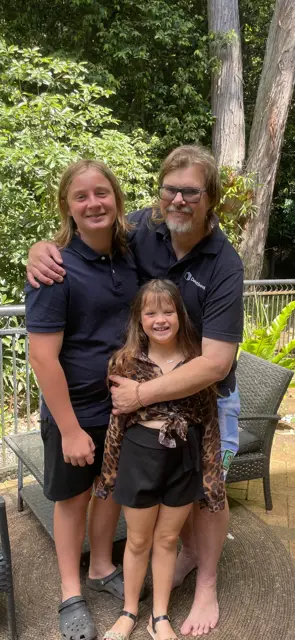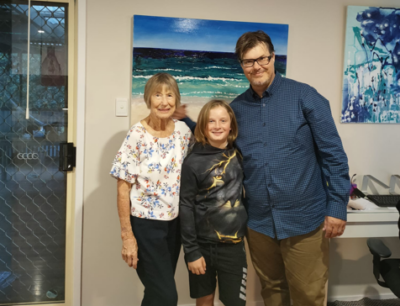Living with Klinefelter Syndrome: Pete Cowley’s Journey of Strength and Resilience
Pete Cowley, a 53-year-old Australian living with Klinefelter syndrome, has lived an adventurous life full of challenges, triumphs, and valuable lessons. Known for his upbeat perspective, Pete enjoys spending time at the beach with his teenage son, Jasper, and embraces the ups and downs of his journey. His story is one of resilience and finding strength in adversity.
Childhood: Growing Up on a Farm
 Pete’s childhood was a blend of excitement and struggle. Growing up on a farm in Australia, he had the freedom to explore the land, ride his motorcycle, swim, and climb trees in the rainforest. Surrounded by dairy cows, macadamia nuts, avocados, and mangos, he felt independent and enjoyed the pleasures of nature.
Pete’s childhood was a blend of excitement and struggle. Growing up on a farm in Australia, he had the freedom to explore the land, ride his motorcycle, swim, and climb trees in the rainforest. Surrounded by dairy cows, macadamia nuts, avocados, and mangos, he felt independent and enjoyed the pleasures of nature.
However, school was a different story. Pete found it difficult to keep up with his peers academically, often struggling to understand lessons or apply what he was taught. This led to disruptions in class and negative reports from teachers. “I didn’t look like I had a disability, so things weren’t as obvious,” Pete recalls, emphasizing the invisible nature of his condition.
Despite his academic struggles, Pete excelled in advanced math and chemistry in high school. He also enjoyed learning about agriculture and played rugby, where his competitive spirit was evident. At the age of fourteen, Pete found himself playing against much older, larger opponents. This experience pushed him to live recklessly, both on and off the field.
The Diagnosis: A Turning Point
At the age of twelve, Pete was diagnosed with Klinefelter syndrome, a condition that occurs when a male is born with an extra X chromosome (XXY). His diagnosis came after he developed large breasts, which led to teasing from his peers and a heightened sense of self-consciousness. “I started hunching my back to hide my breasts,” Pete shares.
His mother took him to multiple doctors in search of answers, but it wasn’t until they consulted a specialist that the condition was diagnosed through a blood test. In the 1980s, many doctors were unfamiliar with Klinefelter syndrome, and the information Pete received was unsettling. The specialist shared a grim prognosis, noting that the average life expectancy was around 30 due to high suicide rates, and that many individuals with Klinefelter syndrome ended up incarcerated.
Amidst this turmoil, Pete underwent a double mastectomy at the age of twelve. Although he was relieved to no longer have breasts, the emotional toll of the diagnosis remained.
Pete’s school environment offered little support for his condition. The school principal’s response to the news was unsupportive, and Pete felt that academic interventions could have made a significant difference during this challenging time. “When my grades dropped and thinking I could possibly die at thirty, I began pushing my body hard,” he explains.
A Reckless Pursuit of Thrills
In his teenage years, Pete sought adrenaline in dangerous activities. He rode his motorcycle at reckless speeds, sometimes exceeding 100 miles per hour, dodging potholes and kangaroos along the way. Rugby, where Pete played as a second row, also served as an outlet for his anger and desire for speed. His body took a beating, with broken bones, cracked vertebrae, and even a knee reconstruction. “They hit and pushed, and my body just got broken,” Pete admits.
Living with Klinefelter Syndrome: Relationships and Self-Acceptance
 Pete’s personality is a mix of introversion and extroversion. While he can be the life of the party and enjoys socializing, he also values his time alone. This balance stems partly from his career in sales, which requires him to be outgoing. However, outside of work, Pete prefers to spend time with smaller groups or by himself.
Pete’s personality is a mix of introversion and extroversion. While he can be the life of the party and enjoys socializing, he also values his time alone. This balance stems partly from his career in sales, which requires him to be outgoing. However, outside of work, Pete prefers to spend time with smaller groups or by himself.
He has always been open about his condition, and though some friends took advantage of his vulnerability in the past, Pete has maintained a positive outlook. “There is some darkness there, but I also had good friends around,” he reflects.
As an adult, Pete’s openness about his XXY diagnosis has led to more meaningful conversations. While infertility is often a topic of discussion, Pete feels no embarrassment about his condition. Instead, he sees it as a part of who he is. “I’m unconventional because my brain is wired differently,” he explains, offering a simple way for others to understand his situation.
Infertility: A Family Journey
Pete has been married twice, and his first wife, who is Jasper’s mother, wanted a child. Knowing that he couldn’t conceive naturally, they decided to use donor sperm. The couple went through a challenging 18-month process, tracking cycles and undergoing hormone treatments until Jasper was born. “It was a challenging time, but Jasper is the best part of my life,” Pete says, without hesitation.
Pete’s bond with his son is strong. They enjoy spending time together at the beach, despite Jasper’s love for video games. Pete values the time he shares with Jasper and strives to be a strong, present figure in his son’s life, especially after losing his father at a young age. Jasper knows about his father’s XXY condition, and Pete is open about discussing it with him.
Testosterone: A Lifelong Journey
 Pete’s treatment with testosterone began when he was diagnosed. In the early days, testosterone was extracted from pig testicles, and the only available form was a monthly injection. Over the years, Pete has seen advancements in testosterone therapy, including a variety of administration options. However, Pete prefers to take testosterone sparingly. He has used it on and off over the past four decades, finding that long-term use made him too aggressive.
Pete’s treatment with testosterone began when he was diagnosed. In the early days, testosterone was extracted from pig testicles, and the only available form was a monthly injection. Over the years, Pete has seen advancements in testosterone therapy, including a variety of administration options. However, Pete prefers to take testosterone sparingly. He has used it on and off over the past four decades, finding that long-term use made him too aggressive.
Advice for Others Living with Klinefelter Syndrome
Pete’s most important advice for those living with Klinefelter syndrome, or for parents of young boys with the condition, is to be proactive. Early intervention, whether through academic support or testosterone therapy, can significantly improve outcomes. “Getting help as early as you can helps lessen any negative impact,” Pete shares.
He also encourages those living with Klinefelter syndrome to find a supportive community. Pete has connected with others online and locally, and these connections have played a crucial role in his self-discovery. His message is clear: having XXY isn’t a life sentence, and there are plenty of exceptional things to experience along the way.
Embracing the Journey
Pete believes that living with Klinefelter syndrome has shaped his identity and his purpose in life. Despite the challenges he has faced, Pete continues to embrace the journey. He has learned that life is more than just a diagnosis, and his message to others is one of hope and strength: “Embrace the journey, connect with others, and know that help is available.”
For more stories and support on living with Klinefelter syndrome, visit Living with XXY. You can find resources, personal stories, and valuable insights to help you navigate the challenges of Klinefelter syndrome. Whether you are living with the condition or supporting a loved one, you’re not alone in this journey.




Leave A Comment